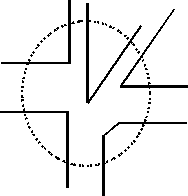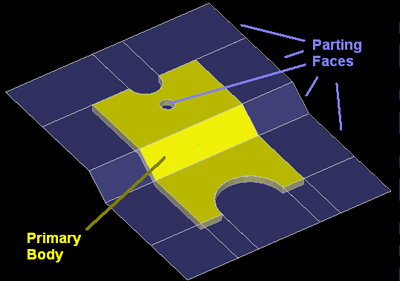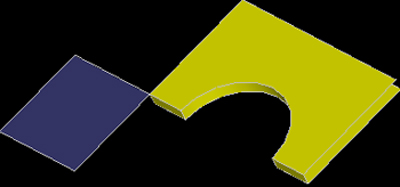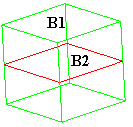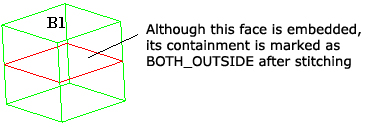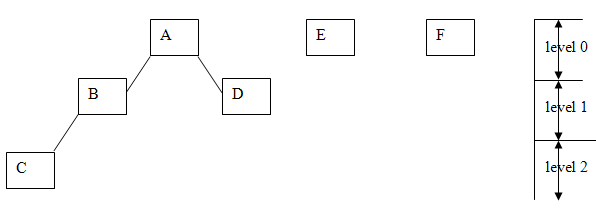Tolerant Stitching
Tolerant Stitching is an operation of api_stitch and api_stitch_nonmanifold when the stitch_options object that is passed into these APIs is of class tolerant_stitch_options. Tolerant stitching stitches two faces only if the common edges/vertices have approximately the same geometry. After stitching is completed, the resulting model is checked for gaps. Edges or vertices with gaps are replaced with TEDGEs and TVERTEXs. This form of stitching should be used in situations where gaps exist between edges that should be stitched together. This situation typically arises with models that have been translated into ACIS from another modeler.
Tolerant stitching has the following characteristics:
- Handles varying gaps.
- Resolves multiple vertices.
- Splits edges appropriately.
- Ensures consistent face normals.
Figure. Example of a Difficult Tolerant Stitching Operation
Tolerant stitching uses an incremental algorithm. Stitching attempts to stitch the body together by starting with a small tolerance (the minimum tolerance) and stitching together as many faces as possible. Then, the tolerance is increased by a small amount and as many remaining faces are stitched as possible. At each tolerance value, edges that are smaller than the tolerance are either removed or merged, depending on their relationship to the adjoining edges. This process is continued until the entire set of faces can be stitched together, or the maximum tolerance is reached. This algorithm provides robustness against difficult stitching problems that can arise, like the one illustrated in the previous figure.
In Tolerant stitching mode, api_stitch and api_stitch_nonmanifold will operate only on BODYs or free FACEs. A free FACE is a FACE that is a top-level entity and has no owner. Note that free FACEs are not legal in ACIS, but the API still accepts them. It is recommended, however, that the API be passed only BODYs.
Two lists: ENTITY_LIST output_bodies and ENTITY_LIST new_bodies, are returned as output from api_stitch and api_stitch_nonmanifold. The list ENTITY_LIST output_bodies contains the complete set of bodies that is output from the API and belong to the caller. In tolerant stitching mode, if free FACEs are passed into the API, then the API will wrap these free FACEs in new BODYs, which are also returned to the output_bodies list. Note that any new BODY created by the API is also returned to the new_bodies list. The list ENTITY_LIST new_bodies contains all the new bodies resulting from the API. This list becomes a subset of ENTITY_LIST output_bodies. This list is provided in order to make it convenient for the callers to determine ownership of the new bodies. The callers may have to register new bodies in their application and/or do memory management of these bodies.
Non-manifold Stitching
The API api_stitch_nonmanifold performs non-manifold stitching between parting faces and part bodies. This API may be used for stitching more than two coedges per edge. This API is specifically catered to support mold and die design processes. The picture below illustrates a primary body, along with its parting faces (just to clarify the terms primary body and parting faces used in this document).
Figure. Primary Body and Parting Faces
For more details on how this API performs non-manifold stitching, refer to the documentation of api_stitch_nonmanifold.
Limitations
- This API api_stitch_nonmanifold will operate only on BODYs or free FACEs. A free FACE is a FACE that is a top-level entity and has no owner. Note that free FACEs are not legal in ACIS, but this API still accepts them. We recommended, however, that this API be passed only BODYs.
- This API does not support vertex stitching. For example, if you give a primary body (shown in yellow) and a parting face (shown in blue) to be stitched at one common vertex, then this API will not stitch the two at the common vertex.
Figure. Non-manifold Vertex Stitching
- This API does not always handle sidedness and containment of faces accurately. If you provide sheet bodies (or free faces) in a parting faces list and a primary bodies list for non-manifold stitching, then all the faces of the stitched non-manifold body returned by this API might be marked DOUBLE_SIDED with containment as BOTH_OUTSIDE, even if a portion of the non-manifold body encloses finite volume. However, if you provide one or more solid bodies (along with or without sheet bodies) in a primary bodies list to be stitched with a parting faces list, then all the faces of the incoming solid bodies will be marked SINGLE_SIDED. The faces of the incoming sheet bodies will be marked DOUBLE_SIDED with containment as BOTH_OUTSIDE.
- This API never marks any DOUBLE_SIDED face as BOTH_INSIDE. If you intend to stitch a model to make an internal partition embedded in a solid, then although this API will stitch the faces, it will not get the containment correct. So such a stitched model will report check errors. In order to correct such a model, you will have to manually set the containment of the internal partition faces to BOTH_INSIDE. The picture below illustrates a model that reports a check error due to wrong containment. Even though the sheet body "B2" in the input acts as an internal partition embedded in a solid yet its containment is not correct at the end of stitching.
Figure. Embedded Face
Figure. Embedded Face Stitched
Failsafe Stitching
The APIs api_stitch and api_stitch_nonmanifold have a failsafe behavior. These APIs attempt to succeed as much as possible and not fail, even in cases where they encounter any geometry and topology related errors. These APIs undo the current atomic transaction that fails due to such errors, raise a sys_warning with the same error message, and proceed further. In cases where the APIs succeed and outcome is successful, you can call the method, outcome::encountered_errors() to determine whether the APIs had encountered any error(s) and still proceeded further.
Warning: If outcome::encountered_errors() returns TRUE, the model may have geometric or topological defects that need to be corrected. To turn off the failsafe behavior, push TRUE into the careful option.
You can determine the result of the APIs by using the return values of the following methods:
- If outcome::encountered_errors() returns FALSE, then it means that the APIs have completely succeeded, that is, no errors were encountered by the APIs. outcome::ok() should always return TRUE in this case.
- If outcome::encountered_errors() returns TRUE and outcome::ok() returns TRUE, then it means that the APIs have encountered error(s), yet proceeded to completion successfully.
- If outcome::ok() returns FALSE, then it means the APIs have failed and rolled the model back to the state before the APIs were called.
Note: Even though these APIs have been made failsafe, they will still continue to fail on certain errors that are irrecoverable. The list of irrecoverable messages are:
INVALID_STITCH_MAX_TOL "Stitch maximum tolerance less than SPAresabs" COINCIDENT_FACES "Attempting to stitch coincident faces is not allowed" (Appears in SPA_STITCH_COIN_ERROR mode only) INPUT_NOT_AN_EDGE "Input list has an entity which is not an EDGE" EDGE_ALREADY_STITCHED "Input edge is already stitched" EDGE_HAS_NO_FACE "Input edge is not connected to any face" NOTHING_TO_STITCH "Nothing to stitch" FACE_WITH_OWNER "Encountered face with owner" UNACCEPTABLE_ENTITY "Unsupported topology encountered" EDGE_HAS_FACE_WITH_NO_BODY "Top level owner of EDGE is neither a FACE nor a BODY" IMPROPER_STITCH_OPTION "Improper stitch_option" FREE_FACE_NOT_SINGLE "Free face contains information of other faces"
